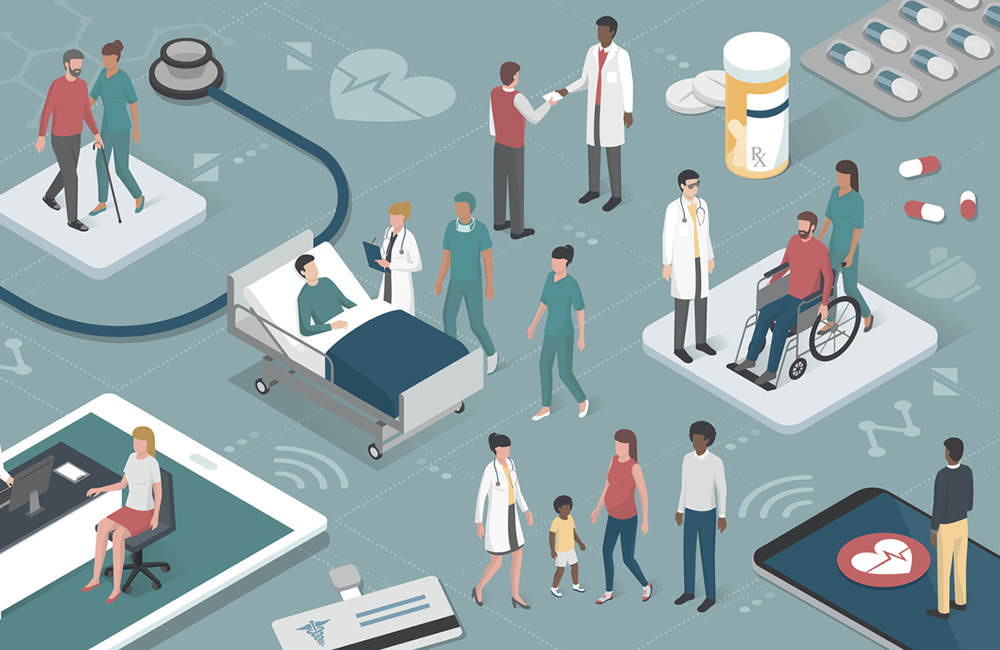‘As-a-Service’ Model Transforms DHA’s Solutions Delivery
The multi-cloud, DevOps-oriented approach is working to improve military health delivery during the pandemic.

The Defense Health Agency has adopted a model of service that shortens and accelerates delivery cycles as the COVID-19 pandemic has heightened the need for rapid response.
The Managed Services Model from the agency’s Solutions Delivery Division (SDD) aims to drive innovation in “as-a-service” offerings around infrastructure (IaaS), platform (PaaS) and software (SaaS), in addition to integrating multi-cloud environments and DevOps culture in the implementation, said division Director Col. Francisco Dominicci at the FedHealth IT Innovation Awards last week.
The division of DHA oversees over 100 different systems, many of which have been developed in a “legacy way,” Dominicci said, adding that those systems’ software are often hard-coded and that the division has provided capabilities that are unique to specific environments that often lead to siloed, slower processes. By leveraging infrastructure, platform and software as services, however, Dominicci hopes to increase capability delivery while reducing costs.
“We’re moving our capabilities and our software in order to provide the same or better capabilities, reduce costs that allow us to rationalize and streamline those applications that we provide to the field,” Dominicci said.
More specifically, SDD is pursing a multi-cloud approach in its IaaS model to meet its infrastructure requirements and to fit the software that the organization is looking to apply in its PaaS contracts. This will ensure SDD has a structural PaaS that enables microservice containerization of applications and a workflow environment that enables SDD to provide the services it wants to deliver, such as an IT service desk.
Dominicci added that his division is adopting a DevOps culture and toolset so that it can achieve its “as-a-service” model. This will enable SDD to automate platform, software and cybersecurity delivery, while having baselines that the division can manage efficiently and effectively.
The Managed Services Model also supports new approaches to cybersecurity and ITIL maturity, Dominicci said. Namely, SDD is adopting a leaner approach to cybersecurity operations, building in well-defined functional cybersecurity roles into all of its partner agreements. It is also increasing the maturity of its ITIL-based support contract framework, aligning its partner expertise into IT processes and function.
This approach has enabled DHA to provide increased and improved support amid the COVID-19 pandemic. Crises with sudden demands for lab capabilities and virtual health capabilities allowed SDD to provide respective support to meet the demand.
More specifically, SDD helped engage on multiple fronts to deploy lab instruments and troubleshoot connectivity issues as well as expedite COVID-19 lab and clinic mapping. SDD also supported military health beneficiaries through the TRICARE Patient Portal by enabling labs to provide COVID-19 test results the instant results became available.
The TRICARE Patient Portal supported over 1 million users in recent months, marking a new milestone for the portal in support capabilities. The trend follows the increase of overall use of telehealth capabilities that DHA has seen as the agency pivoted its approach to care amid COVID-19.
DHA Assistant Director for Management Dr. Barclay Butler reported further evidence of military treatment facilities’ overall adjustment to virtual health care. Face-to-face care decreased from 80% to 38% of primary care at military treatment facilities amid COVID-19 while virtual health went from 20% to 62% of primary care, Butler said. Tele-ICU capabilities also saw significant increases in recent months.
DHA was also able to ramp up provider licensing in its virtual medical center systems from about 500 licensed clinicians to over 5,200 — an over tenfold increase. Increasing telehealth also increased access to care, Butler added, sharing that patients were able to get care when needed at an 82% rate, a 5% boost from 77% before COVID-19.
Despite the challenges that COVID-19 has brought across the country and the rest of the world, DHA leaders aimed to seek the silver lining of the pandemic — that the pressure of the crisis have increased the pace of technological change and are informing the future of care across defense health.
“[We’re] really applying those lessons learned using the COVID-19 response as a driver for changing how we do things in the Defense Health Agency,” Butler said. “As far as clinical effectiveness is concerned, we believe that this is continued to have high-quality care. … As we follow this virtual health care, in terms of value, we were able to continue to [help] our care teams in provision of care, and that really kept our knowledge, skills and abilities up and reduced our network referrals.”
As military treatment facilities and frontline defense health professionals continue to respond to COVID-19, SDD will also continue pushing its technological and service delivery forward to meet the demands of the pandemic and military health overall, collaborating with industry and federal partners to achieve its goals.
“SDD is moving into the future,” Dominicci said. “We are excited about the future and our capabilities are going to be to partnered with all members of the team, the DHA team, as well as other capabilities [at] the VA and DHMS and other environments that allow us to deliver these capabilities to these applications.”
This is a carousel with manually rotating slides. Use Next and Previous buttons to navigate or jump to a slide with the slide dots
-

Inside DOD’s Push to Grow the Cyber Workforce Through Academia
Diba Hadi gives her first interview since becoming principal director of the DOD’s Cyber Academic Engagement Office.
15m listen -

Agencies Tackle Infrastructure Challenges to Drive AI Adoption
Federal agencies are rethinking data strategies and IT modernization to drive mission impact and operational efficiency as new presidential directives guide next steps.
5m read Partner Content -

Generative AI Demands Federal Workforce Readiness, Officials Say
NASA and DOI outline new generative AI use cases and stress that successful AI adoption depends on strong change management.
6m read -

The Next AI Wave Requires Stronger Cyber Defenses, Data Management
IT officials warn of new vulnerabilities posed by AI as agencies continue to leverage the tech to boost operational efficiency.
5m read -

Federal CIOs Push for ROI-Focused Modernization to Advance Mission Goals
CIOs focus on return on investment, data governance and application modernization to drive mission outcomes as agencies adopt new tech tools.
4m read -

Fed Efficiency Drive Includes Code-Sharing Law, Metahumans
By reusing existing code instead of rewriting it, agencies could dramatically cut costs under the soon-to-be-enacted SHARE IT Act.
5m read -

Agencies Push Data-Driven Acquisition Reforms to Boost Efficiency
New initiatives aim to increase visibility of agency spending, improve data quality and create avenues to deploy solutions across government.
5m read -

Data Transparency Essential to Government Reform, Rep. Sessions Says
Co-Chair of the Congressional DOGE Caucus Rep. Pete Sessions calls for data sharing and partnerships to reduce waste and improve efficiency.
5m read -

DOD Turns to Skills-Based Hiring to Build Next-Gen Cyber Workforce
Mark Gorak discusses DOD’s efforts to build a diverse cyber workforce, including skills-based hiring and partnerships with over 480 schools.
20m listen -

AI Foundations Driving Government Efficiency
Federal agencies are modernizing systems, managing risk and building trust to scale responsible AI and drive government efficiency.
40m watch -

Trump Executive Order Boosts HBCUs Role in Building Federal Tech Workforce
The executive order empowers HBCUs to develop tech talent pipelines and expand access to federal workforce opportunities.
3m read -

Navy Memo Maps Tech Priorities for the Future Fight
Acting CTO’s memo outlines critical investment areas, from AI and quantum to cyber and space, as part of an accelerated modernization push.
5m read




